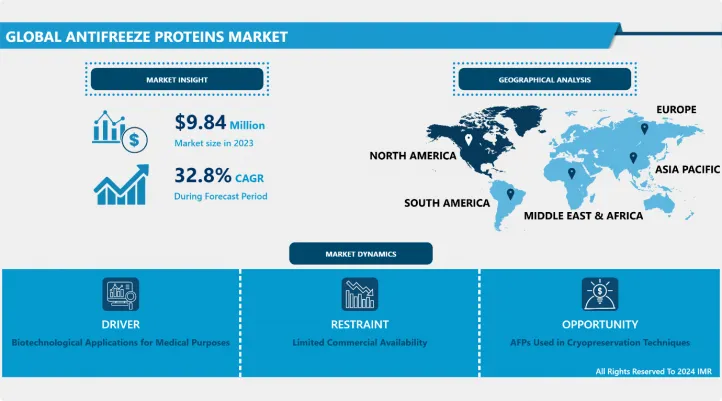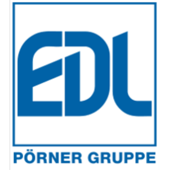Antifreeze Proteins Market Synopsis
Antifreeze Proteins Market Size Was Valued at USD 9.84 Million in 2023 and is Projected to Reach USD 126.41 Million by 2032, Growing at a CAGR of 32.8% From 2024-2032.
Antifreeze proteins (AFPs) are naturally occurring substances found in certain organisms, such as fish, plants, insects, and microorganisms. These proteins help the organisms survive in extremely cold environments by preventing the formation of ice crystals within their cells and tissues. AFPs work by binding to ice crystals and inhibiting their growth, thereby lowering the freezing point of the organism's bodily fluids. This ability to prevent ice formation or growth is crucial for the survival of organisms living in icy environments, as it helps prevent cellular damage caused by freezing temperatures.
- Antifreeze proteins (AFPs) have numerous applications in various fields, including cryopreservation, food industry, agriculture, biotechnology, and cosmetics. They can preserve biological materials at low temperatures, extending their viability and improving the quality and texture of frozen foods. They can also be used in agriculture to protect crops from frost damage, increasing yields and food security. In biotechnology and biomedicine, AFPs stabilize proteins and enzymes at low temperatures, improving the storage and transportation of sensitive biopharmaceuticals and diagnostic reagents.
- Antifreeze proteins also be used in cosmetics to formulate anti-aging creams and skincare products, preventing ice crystal formation in skin cells. In material science, AFPs have inspired the development of biomimetic materials with antifreeze properties, which could be used in ice-repellent coatings, cryogenic engineering, and cold environment construction. AFPs have potential applications in medicine, food industry, biotechnology, agriculture, and cosmetics.
- Antifreeze proteins help prevent ice formation and damage during freezing and thawing processes, improving cell and tissue viability. They can enhance the quality and shelf life of frozen foods by inhibiting ice crystal formation. AFPs also protect cells and proteins from freezing and thawing damage, making them valuable in biotechnological processes like recombinant protein production and genetic preservation. They can also protect crops from frost damage by reducing ice formation in plant tissues. AFPs could also improve the stability and texture of skincare products.
Antifreeze Proteins Market Trend Analysis
Biotechnological Applications for Medical Purposes
- Antifreeze proteins (AFPs) are proteins found in certain organisms, particularly those living in extremely cold environments, that protect them from the harmful effects of ice formation and low temperatures. These proteins work by binding to ice crystals, inhibiting their growth, and preventing the formation of large ice masses that could damage cells and tissues.
- In recent years, there has been growing interest in the biotechnological applications of AFPs for medical purposes. Key drivers include cryopreservation, organ transplantation, biopharmaceuticals, tissue engineering, and cold storage of biological samples. Cryopreservation is a process of preserving cells, tissues, or organs at low temperatures for extended periods, improving viability and survival rates.
- Organ transplantation extends the preservation time of organs outside the body, increasing the availability of viable donor organs and improving transplant outcomes. AFPs also have potential applications in tissue engineering and regenerative medicine, enhancing the preservation and viability of engineered tissues and organs. Cold storage of biological samples, such as blood, cells, and tissues, can be enhanced by minimizing freeze-thaw damage, improving the integrity and quality of stored samples.
Restraint
Limited Commercial Availability
- The commercialization of antifreeze proteins (AFPs) faces several challenges due to their limited availability in nature and the difficulty in mass-producing them artificially. These naturally occurring substances, found in organisms like fish, insects, and plants, help them survive in freezing environments by preventing ice crystal formation.
- However, their commercialization is hindered by limited natural sources, complex molecular structures, regulatory hurdles related to safety, efficacy, and environmental impact, high production costs, and intellectual property issues. Despite these challenges, AFPs have potential applications in food preservation, medicine, and cryopreservation. Therefore, they remain a valuable resource for researchers and companies in the field.
Opportunity
AFPs Used in Cryopreservation Techniques
- Antifreeze Proteins (AFPs) offer a promising opportunity in cryopreservation techniques, which involve preserving biological materials at ultra-low temperatures to maintain their viability for extended periods. AFPs, naturally occurring proteins found in certain organisms, protect cells and tissues from freezing damage by binding to ice crystals and inhibiting their growth.
- AFPs also enhance cell viability, particularly for delicate samples like stem cells and tissues for transplantation. AFPs can be used in cryopreservation solutions or coatings, allowing for the preservation of a wider range of biological materials under varied conditions.
- AFPs have potential applications in biomedical and biotechnological fields, such as organ transplantation, genetic material preservation, and low-temperature pharmaceutical storage. AFPs also offer economic and environmental benefits, reducing resource consumption and cost savings by enhancing storage and transportation processes for biological materials.
Challenge
Face Regulatory Hurdles, Particularly Regarding Their Safety for Use in Food and Medical
- Antifreeze proteins (AFPs) face significant regulatory challenges, particularly in their safety for use in food and medical applications. These include safety concerns, such as allergic reactions or health effects, and obtaining approval from agencies like the FDA or EFSA.
- AFPs may also be considered novel foods due to their unconventional nature, requiring comprehensive safety assessments before market approval. Clear labeling is necessary for AFP-containing items to inform consumers and enable informed choices. Medical device regulations vary depending on the intended use, such as cryopreservation or organ transplantation.
- Ethical considerations regarding sourcing, production methods, and potential health impact are also considered. Regulatory agencies may also evaluate the environmental impact of AFPs, particularly if they are derived from GMOs or have the potential to affect ecosystems.
Antifreeze Proteins Market Segment Analysis:
Antifreeze Proteins Market Segmented based on type, form, source, and end-users.
By Type, Type I AFPs segment is expected to dominate the market during the forecast period
- Antifreeze proteins (AFPs) are essential for organisms to survive in cold environments by preventing ice crystal formation. Type I AFPs are expected to dominate the market due to their widespread application, versatility, and commercial viability. They are effective in preventing ice formation and improving the stability of biological materials like food products, organs for transplantation, and pharmaceuticals.
- They also have the potential to enhance the quality and shelf life of perishable goods, reduce refrigeration costs, and improve medical treatments. Significant investment and research have led to advancements in understanding their structure, function, and potential applications. Additionally, Type I AFPs may already have or are nearing regulatory approval for use in certain industries, facilitating their adoption and commercialization.
By Form, Solid Segment Held the Largest Share of 62.5% in 2023
- The solid segment in the antifreeze proteins market is dominated by its wide range of applications, longer shelf life, ease of formulation, increased stability, and cost-effectiveness. These proteins are preferred in industries like food, medical, and cosmetics due to their stability and ease of handling.
- Solid AFP have a longer shelf life, making them suitable for storage and distribution. They can be easily formulated into various products, making them attractive for manufacturers. They also exhibit greater stability under various environmental conditions, ensuring consistent performance in temperature-sensitive applications.
Antifreeze Proteins Market Regional Insights:
North America is Expected to Dominate the Market Over the Forecast Period
- North America, is home to numerous research institutions, universities, and biotechnology companies that are actively involved in the study and development of antifreeze proteins. These institutions contribute to advancements in understanding the properties and applications of antifreeze proteins, driving innovation in the field.
- The region boasts a strong presence in the biotechnology industry, with a robust ecosystem supporting the development and commercialization of biotech products. This infrastructure provides a conducive environment for the production and distribution of antifreeze proteins for various applications, including cryopreservation, food processing, and medical technologies.
- North America's diverse industries, including healthcare, food and beverage, and cosmetics, have a growing need for antifreeze proteins in various applications. However, the food industry utilizes antifreeze proteins to enhance the quality and shelf life of frozen food products. North America has well-established regulatory frameworks governing the use of biotechnological products, ensuring safety and efficacy standards are met.
Antifreeze Proteins Market Top Key Players:
- Selleck Chemicals (US)
- AFChemPharm (US)
- A/F Protein Inc. (Canada)
- Sirona Biochem Corp. (Canada)
- ProtoKinetix Inc. (Canada)
- Unilever (UK)
- Deep Branch (UK)
- Groupe Danone (France)
- Glanbia Nutritionals (Ireland)
- Qingdao BZ-Oligo Biotech Co., Ltd. (China)
- Nichirei Corporation (Japan)
- Kaneka Corporation (Japan), and other major players
Key Industry Developments in the Antifreeze Proteins Market:
- In February 2024, Sirona Biochem Launched GlycoProteMimTM in Early 2025. Vancouver, British Columbia. Sirona Biochem Corp. also known as Sirona, is excited to share a new milestone in its journey. Dr. Deliencourt-Godefroy unveils Sirona’s ambitious plans to introduce its innovative anti-aging product, GlycoProteMimTM, to the markets of North America and Europe in early 2025.
- In May 2021, Unilever announced that it will partner with food-tech company ENOUGH to bring new plant-based meat products to market. Enough’s technology uses a unique zero-waste fermentation process to grow a high-quality protein. Natural fungi are fed with renewable feedstock, such as wheat and corn. This produces ABUNDA® mycoprotein, a complete food ingredient containing all essential amino acids as well as being high in dietary fiber.
|
Global Antifreeze Proteins Market |
|||
|
Base Year: |
2023 |
Forecast Period: |
2024-2032 |
|
Historical Data: |
2017 to 2023 |
Market Size in 2023: |
9.84 Mn |
|
Forecast Period 2024-30 CAGR: |
32.8% |
Market Size in 2032: |
126.41 Mn |
|
Segments Covered: |
By Type |
|
|
|
By Form |
|
||
|
By Source |
|
||
|
By End User |
|
||
|
By Region |
|
||
|
Key Market Drivers: |
|
||
|
Key Market Restraints: |
|
||
|
Key Opportunities: |
|
||
|
Companies Covered in the report: |
|
||
- INTRODUCTION
- RESEARCH OBJECTIVES
- RESEARCH METHODOLOGY
- RESEARCH PROCESS
- SCOPE AND COVERAGE
- Market Definition
- Key Questions Answered
- MARKET SEGMENTATION
- EXECUTIVE SUMMARY
- MARKET OVERVIEW
- GROWTH OPPORTUNITIES BY SEGMENT
- MARKET LANDSCAPE
- PORTER’S FIVE FORCES ANALYSIS
- Bargaining Power Of Supplier
- Threat Of New Entrants
- Threat Of Substitutes
- Competitive Rivalry
- Bargaining Power Among Buyers
- INDUSTRY VALUE CHAIN ANALYSIS
- MARKET DYNAMICS
- Drivers
- Restraints
- Opportunities
- Challenges
- MARKET TREND ANALYSIS
- REGULATORY LANDSCAPE
- PESTLE ANALYSIS
- PRICE TREND ANALYSIS
- PATENT ANALYSIS
- TECHNOLOGY EVALUATION
- MARKET IMPACT OF THE RUSSIA-UKRAINE WAR
- Geopolitical Market Disruptions
- Supply Chain Disruptions
- Instability in Emerging Markets
- ECOSYSTEM
- PORTER’S FIVE FORCES ANALYSIS
- ANTIFREEZE PROTEINS MARKET BY TYPE (2017-2030)
- ANTIFREEZE PROTEINS MARKET SNAPSHOT AND GROWTH ENGINE
- MARKET OVERVIEW
- TYPE I AFPS
- Introduction And Market Overview
- Historic And Forecasted Market Size in Value (2017 – 2030F)
- Historic And Forecasted Market Size in Volume (2017 – 2030F)
- Key Market Trends, Growth Factors And Opportunities
- Geographic Segmentation Analysis
- TYPE II AFPS
- ICE-NUCLEATING PROTEINS
- ANTIFREEZE GLYCOPROTEIN
- ANTIFREEZE PROTEINS MARKET BY FORM (2017-2030)
- ANTIFREEZE PROTEINS MARKET SNAPSHOT AND GROWTH ENGINE
- MARKET OVERVIEW
- SOLID
- Introduction And Market Overview
- Historic And Forecasted Market Size in Value (2017 – 2030F)
- Historic And Forecasted Market Size in Volume (2017 – 2030F)
- Key Market Trends, Growth Factors And Opportunities
- Geographic Segmentation Analysis
- LIQUID
- ANTIFREEZE PROTEINS MARKET BY SOURCE (2017-2030)
- ANTIFREEZE PROTEINS MARKET SNAPSHOT AND GROWTH ENGINE
- MARKET OVERVIEW
- PLANT
- Introduction And Market Overview
- Historic And Forecasted Market Size in Value (2017 – 2030F)
- Historic And Forecasted Market Size in Volume (2017 – 2030F)
- Key Market Trends, Growth Factors And Opportunities
- Geographic Segmentation Analysis
- FISH
- INSECT
- ANTIFREEZE PROTEINS MARKET BY END-USER (2017-2030)
- ANTIFREEZE PROTEINS MARKET SNAPSHOT AND GROWTH ENGINE
- MARKET OVERVIEW
- MEDICAL
- Introduction And Market Overview
- Historic And Forecasted Market Size in Value (2017 – 2030F)
- Historic And Forecasted Market Size in Volume (2017 – 2030F)
- Key Market Trends, Growth Factors And Opportunities
- Geographic Segmentation Analysis
- COSMETICS
- FOOD
- COMPANY PROFILES AND COMPETITIVE ANALYSIS
- COMPETITIVE LANDSCAPE
- Competitive Positioning
- Antifreeze Proteins Market Share By Manufacturer (2022)
- Industry BCG Matrix
- Heat Map Analysis
- Mergers & Acquisitions
- SELLECK CHEMICALS (US)
- Company Overview
- Key Executives
- Company Snapshot
- Role of the Company in the Market
- Sustainability and Social Responsibility
- Operating Business Segments
- Product Portfolio
- Business Performance (Production Volume, Sales Volume, Sales Margin, Production Capacity, Capacity Utilization Rate)
- Key Strategic Moves And Recent Developments
- SWOT Analysis
- AFCHEMPHARM (US)
- A/F PROTEIN INC. (CANADA)
- SIRONA BIOCHEM CORP. (CANADA)
- PROTOKINETIX INC. (CANADA)
- UNILEVER (UK)
- DEEP BRANCH (UK)
- GROUPE DANONE (FRANCE)
- GLANBIA NUTRITIONALS (IRELAND)
- QINGDAO BZ-OLIGO BIOTECH CO., LTD. (CHINA)
- NICHIREI CORPORATION (JAPAN)
- KANEKA CORPORATION (JAPAN)
- COMPETITIVE LANDSCAPE
- GLOBAL ANTIFREEZE PROTEINS MARKET BY REGION
- OVERVIEW
- NORTH AMERICA
- Key Market Trends, Growth Factors And Opportunities
- Key Manufacturers
- Historic And Forecasted Market Size By Type
- Historic And Forecasted Market Size By Form
- Historic And Forecasted Market Size By Source
- Historic And Forecasted Market Size By End User
- Historic And Forecasted Market Size By Country
- USA
- Canada
- Mexico
- EASTERN EUROPE
- Key Market Trends, Growth Factors And Opportunities
- Key Manufacturers
- Historic And Forecasted Market Size By Segments
- Historic And Forecasted Market Size By Country
- Russia
- Bulgaria
- The Czech Republic
- Hungary
- Poland
- Romania
- Rest Of Eastern Europe
- WESTERN EUROPE
- Key Market Trends, Growth Factors And Opportunities
- Key Manufacturers
- Historic And Forecasted Market Size By Segments
- Historic And Forecasted Market Size By Country
- Germany
- United Kingdom
- France
- The Netherlands
- Italy
- Spain
- Rest Of Western Europe
- ASIA PACIFIC
- Key Market Trends, Growth Factors And Opportunities
- Key Manufacturers
- Historic And Forecasted Market Size By Segments
- Historic And Forecasted Market Size By Country
- China
- India
- Japan
- South Korea
- Malaysia
- Thailand
- Vietnam
- The Philippines
- Australia
- New-Zealand
- Rest Of APAC
- MIDDLE EAST & AFRICA
- Key Market Trends, Growth Factors And Opportunities
- Key Manufacturers
- Historic And Forecasted Market Size By Segments
- Historic And Forecasted Market Size By Country
- Turkey
- Bahrain
- Kuwait
- Saudi Arabia
- Qatar
- UAE
- Israel
- South Africa
- SOUTH AMERICA
- Key Market Trends, Growth Factors And Opportunities
- Key Manufacturers
- Historic And Forecasted Market Size By Segments
- Historic And Forecasted Market Size By Country
- Brazil
- Argentina
- Rest of South America
- INVESTMENT ANALYSIS
- ANALYST VIEWPOINT AND CONCLUSION
- Recommendations and Concluding Analysis
- Potential Market Strategies
|
Global Antifreeze Proteins Market |
|||
|
Base Year: |
2023 |
Forecast Period: |
2024-2032 |
|
Historical Data: |
2017 to 2023 |
Market Size in 2023: |
9.84 Mn |
|
Forecast Period 2024-30 CAGR: |
32.8% |
Market Size in 2032: |
126.41 Mn |
|
Segments Covered: |
By Type |
|
|
|
By Form |
|
||
|
By Source |
|
||
|
By End User |
|
||
|
By Region |
|
||
|
Key Market Drivers: |
|
||
|
Key Market Restraints: |
|
||
|
Key Opportunities: |
|
||
|
Companies Covered in the report: |
|
||
Frequently Asked Questions :
The forecast period in the Antifreeze Proteins Market research report is 2024-2030.
Selleck Chemicals (US), AFChemPharm (US), A/F Protein Inc. (Canada), Sirona Biochem Corp. (Canada), ProtoKinetix Inc. (Canada), Unilever (UK), Deep Branch (UK), Groupe Danone (France), Glanbia Nutritionals (Ireland), Qingdao BZ-Oligo Biotech Co., Ltd. (China), Nichirei Corporation (Japan), Kaneka Corporation (Japan), and Other Major Players.
The Antifreeze Proteins Market is segmented into Type, Form, Source, End User, and region. By Type, the market is categorized into Type I AFPs, Type II AFPs, Ice-Nucleating Proteins, and Antifreeze Glycoprotein. By Form, the market is categorized into Solid and liquid. By Source, the market is categorized into Fish, Plants, and Insects. By End User, the market is categorized into Medical, Cosmetics, Food, and Other. By region, it is analyzed across North America (U.S.; Canada; Mexico), Eastern Europe (Bulgaria; The Czech Republic; Hungary; Poland; Romania; Rest of Eastern Europe), Western Europe (Germany; UK; France; Netherlands; Italy; Russia; Spain; Rest of Western Europe), Asia-Pacific (China; India; Japan; Southeast Asia, etc.), South America (Brazil; Argentina, etc.), Middle East & Africa (Saudi Arabia; South Africa, etc.).
The Antifreeze Proteins Market refers to the global industry involved in the production, distribution, and commercialization of proteins that exhibit antifreeze properties. These proteins are naturally found in certain organisms, such as fish, plants, and insects, and they enable these organisms to survive in freezing environments by preventing ice crystal formation or growth. In the market, antifreeze proteins are utilized in various applications, including cryopreservation of cells and tissues, frozen food storage, cosmetics, and medical technologies. The market is driven by the increasing demand for cryopreservation techniques, advancements in biotechnology research, and the expanding applications of antifreeze proteins across different industries. Major players in the market include biotechnology companies, research institutions, and manufacturers catering to diverse industrial sectors.
Antifreeze Proteins Market Size Was Valued at USD 9.84 Million in 2023 and is Projected to Reach USD 126.41 Million by 2032, Growing at a CAGR of 32.8% From 2024-2032.
















